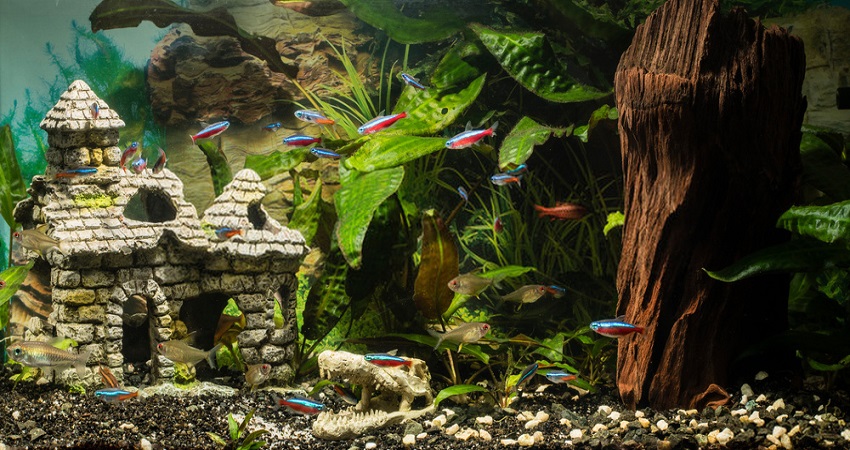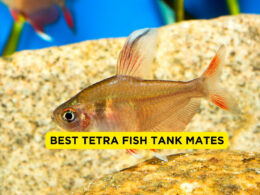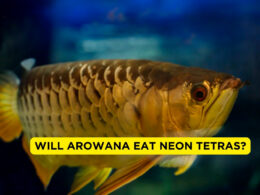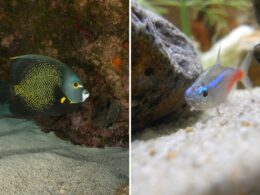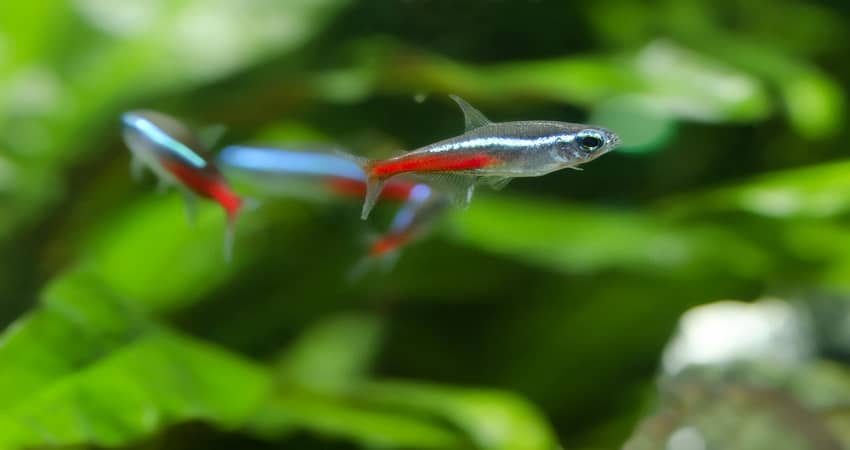In this article Show
Neon tetras are types of tetras fish that generally stay at water bodies that are fresh such that they have inlets and outlets from a specific family. Neon tetras are small in size and have a specific attractive color that they are pets for aquarium learners.
To get a neon tetra, find an appropriate location, including places that store pets since they are delicate and need proper maintenance to survive. Therefore the tetras must live in good conditions where the aquarist must take good care of their habitat to their breeding site.
To keep and maintain the health of a neon tetra, aquarists must have a tank size with good condition of water including the temperature and acidity level, ensure the breeding site is secure for easy sexing of the neon tetra for reproduction, take good care by cleaning the water and preventing dirty water from going into it, providing food for the pets and some other factors that will keep them safe.
The article below shows the habitat whereby it is the usual place the neon tetras stay, care for the preventive measures and how to take care of them, feeding the neon tetra, including the type of food they eat, and the tank size of the tetra and their breeding sites.
Please note the following factors to maintain your neon tetras in the aquarium for a long as they also increase the lifespan of the animals.
Also worth reading;
- Do Neon Tetras Need Oxygen And Air Pump?
- How Many Tetras In A 5-Gallon Tank?
- How To Sex Neon Tetras? (Male Or Female)
- Do Neon Tetras Lose Color at Night? – You Need to Know
Neon Tetra – Habitat, Care, Feeding, Tank Size, Breeding
Here are the important factors to note about neon tetra;
1. Habitat
Habitat is the natural place the neon tetras usually live, including the water bodies that are the fresh waters in most cases.
Neon tetras naturally stay in particular continents like South America with clean water sources like rivers and streams. The habitat of neon tetras must be in soft water bodies that are slightly acidic.
The water temperatures must range from 20 degrees Celsius to 26 degrees Celsius since the sources are from places around the tropics.
Most aquarists who need the wild neon tetras visit American countries with the Amazon rivers with freshwaters. The aquarist gets the neon tetras from their wild natural sources to the stores, keeping them as pets at specific farms, mainly in Singapore and Thailand.
Since the neon tetras are mostly for trade after getting out of their natural habitat, they must train to help them adapt to their artificial stores.
2. Tank Size
The tank size of the aquariums, which are the places that store the neon tetras, must be some inches since one neon tetra requires two gallons, whereas an aquarium with small neon tetras must have 10 gallons as an aquarium with large neon tetras must have 20 gallons.
The tank size determines the rest of the tank’s requirements, including the substrate, the plants the tank has with its decorations, and the light in the tank.
The substrate is the overall design of the tank, whereby the substrate and the natural color of the neon tetras must not be the same since the neon tetras mostly rest at the center of the aquarium.
Consider the color of the neon tetras when choosing a substrate since the substrate has to balance with the neon tetra; therefore, it is advisable to use sand when using an aquarium that will have plants.
The tank size must be able to accommodate more plants that will decorate the tank. When the neon tetras are in the wilderness, they mostly move to stay in areas with most vegetation that have flowers on top of the waters and some floaters that help diffuse light into the water for the neon tetras for visibility.
Plants in the tank must survive in waters with a low level of light and have some acidity since tanks do not allow the penetration of light in their walls. Plants in the tank help maintain water quality and absorb dirty particles in the water that can harm the neon tetras since plants’ color blends with the color of the neon tetra.
In most cases, aquarists opt to use driftwood, rocks, and caves with smooth ends not to harm the fish.
Tank size determines the amount of light that penetrates the neon tetras since the neon tetras can only survive in areas with a low amount of light. The tank plants also help reduce the amount of light penetrating the tank since they float on top of the water.
Do you want to know about Do Neon Tetra Jump Out of Tank?
3. Care
Caring for neon involves the total management of the lives of the neon tetras, including their habitat, the food they consume, and the overall life of the animal.
Since the neon tetras live in areas with water, the aquarist must ensure the waters’ temperatures are low; the light is low to medium level. In other words, the conditions of the water and its surrounding must be fit for the neon tetra.
When taking care of the tank, ensure the tank is mature enough to handle the neon tetras and proper cycling of water in and out of the tank.
Ensure the neon tetras surrounding them meet their requirements from the waters they stay from to the food they consume. Clean the tank by filtering the water going into the tank, and the water must be warm. The tank must be away from nitrates and ammonia, and the water must have a low PH level.
4. Feeding
Neon tetras are omnivorous animals that mainly feed on plants; hence the aquarist must provide pellets with smooth edges for the soft and small sizes of the neon tetras’ mouth.
Neon tetras can also consume some foods that also live like daphnia, tubifex, blood worms, and brine shrimp. However, live foods can harm the neon tetras if they have parasites that when the neon tetras consume, they can face diseases. It is advisable to give the neon tetras small sizes of live food as large sizes can affect them as they struggle to swallow the food.
When the neon tetras feed on meals with parasites, they get infections since the parasites start eating the neon tetras from the inside. But after the diseases, they will still show signs with their bodies as some will lose their colors and lumpy exteriors, they can be restless, and some find it hard to swim.
Therefore to prevent infections, it is better to provide food to the neon tetras from valid sources or plant the pellets since it is more secure for the animals. Ensure you feed the neon tetras daily since they are always swimming depending on their ages, as young ones must eat more than the older ones.
5. Breeding
During the breeding days, ensure the water conditions for mating are secure and safe for breeding since the animals can lay eggs and eat t
them, bringing difficulty in inbreeding. Ensure you identify the male and female neon tetras since they appear the same when laying eggs.
Neon tetras must eat proteins to increase the rate of laying eggs. The tank must meet its specifications with water conditions so that when the neon tetras are ready for breeding, the female tetras will lay eggs that the male ones fertilize, so make sure the tank is dark enough to prevent the tetras from seeing the eggs.
After laying eggs and fertilization, ensure you remove the neon tetras and leave the eggs to hatch after one day. Ensure you use a different tank for breeding since the rates of survival for the neon tetras will be high.
You can then start feeding them after removing the fry from the egg sack and feed them until they become mature.
Feed them first with the baby brine shrimp and micro worms, then go to the pellets after some time, then find a proper diet for them after about one or two months of hatching.
Can A Single Neon Tetra Stay In A Tank?
A single neon tetra cannot stay in a tank since it can start suffering from loneliness, weakening its immune system, and it can quickly get sick and die.
Therefore it is advisable to keep more than one neon tetra in a tank for companies as they enjoy swimming in the tank when having friends. The good thing with the neon tetras is that they do not fight or cause harm to themselves since they are peaceful.
Keeping the neon tetras with different tetras like cardinal tetras, black neon’s, and black skirt tetras to produce quality breeds is good. However, take care of some animals as they can start consuming the neon tetras due to their harshness in nature while these are quite polite.
Conclusion
The article gives the adaptations of the neon tetras in stores with the temperatures and the amounts of light. Neon tetras are delicate animals that need intense care with their places of living and their food.
Therefore, ensure the tank they live in meets the water conditions and provides safe food for the neon tetras since their diseases mainly result from the food they usually consume. Finally, ensure you place enough food for the Neon tetra species.
More about Neon Tetra you should watch this video below;






